
|
It brightened up to 6.2 mag in June (June 24, Marco Goiato). Now it is fading. It has already faded down to 11.7 mag (Sept. 5, Thomas Lehmann). It it not observable already in the Northern Hemisphere. In the Southern Hemisphere, it will be getting lower after this, and will be unobservable in October.
Date(TT) R.A. (2000) Decl. Delta r Elong. m1 Best Time(A, h)
Sept.17 14 23.46 -27 56.2 2.989 2.461 49 11.3 19:16 ( 76, 31)
Sept.24 14 26.32 -27 55.7 3.164 2.535 43 11.5 19:22 ( 72, 25)
|
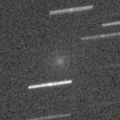
|
New comet. Now it is bright as 12.9 mag (Sept. 14, Alan Hale). It will approach to the Sun down to 0.45 a.u. on Oct. 10. In the Northern Hemisphere, it will be unobservable in late September, then it will never be observable again. In the Southern Hemisphere, it is not observable now. It will appear in the evening sky at 14 mag in November, but it keeps extremely low after that. It has a very similar orbit to Comet C/1915 R1 ( Mellish ).
Date(TT) R.A. (2000) Decl. Delta r Elong. m1 Best Time(A, h)
Sept.17 10 28.57 26 21.5 1.420 0.736 29 12.9 4:32 (249,-17)
Sept.24 11 24.22 22 46.4 1.352 0.616 25 12.1 4:22 (257,-23)
|
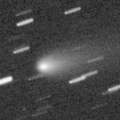
|
Now it is 11.3 mag (Sept. 1, Sandor Szabo). It is observable at 12 mag from summer to autumn, but it keeps low for some time. Juan Jose Gonzalez reported it so bright as 9.5 mag on Sept. 9.
Date(TT) R.A. (2000) Decl. Delta r Elong. m1 Best Time(A, h)
Sept.17 8 49.90 11 16.4 1.952 1.395 42 12.2 4:32 (248, 11)
Sept.24 9 10.02 8 49.6 1.947 1.415 44 12.3 4:22 (250, 12)
|
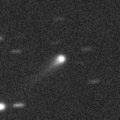
|
It brightened rapidly up to 13.4 mag (Aug. 31, Sandor Szabo). It will be observable at 12-13 mag until autumn. Juan Jose Gonzalez reported it so bright as 10.0 mag on Sept. 5.
Date(TT) R.A. (2000) Decl. Delta r Elong. m1 Best Time(A, h)
Sept.17 15 29.09 -15 47.5 2.305 1.995 59 12.3 19:16 ( 98, 39)
Sept.24 15 44.69 -16 10.5 2.359 1.990 56 12.3 19:22 ( 95, 36)
|
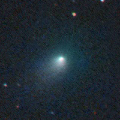
|
Now it is 12.6 mag (Aug. 20, Thomas Lehmann). It will be fading gradually after this. In the Northern Hemisphere, it keeps low for a long time after this.. In the Southern Hemisphere, it keeps observable in good condition for a long time.
Date(TT) R.A. (2000) Decl. Delta r Elong. m1 Best Time(A, h)
Sept.17 15 49.05 -24 34.7 1.722 1.606 66 12.3 19:16 ( 90, 47)
Sept.24 16 10.58 -26 4.1 1.783 1.626 64 12.5 19:22 ( 87, 46)
|
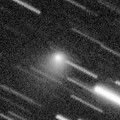
|
Now it is so bright as 11.9 mag (Sept. 9, J. P. Navarro Pina). It will be low in November, but it keeps observable in good condition for a while.
Date(TT) R.A. (2000) Decl. Delta r Elong. m1 Best Time(A, h)
Sept.17 19 41.16 12 13.9 1.187 1.893 119 12.7 19:53 (180, 43)
Sept.24 19 20.59 5 10.5 1.324 1.904 109 13.0 19:22 (173, 50)
|

|
Now it is 11.1 mag (July 31, Chris Wyatt). It is not observable now in the Northern Hemisphere. It will be unobservable soon also in the Southern Hemisphere.
Date(TT) R.A. (2000) Decl. Delta r Elong. m1 Best Time(A, h)
Sept.17 13 10.10 -5 11.6 2.564 1.695 23 12.8 19:16 ( 87, 5)
Sept.24 13 28.67 -7 1.9 2.607 1.719 22 13.0 19:22 ( 83, 3)
|

|
It brightened up to 8-9 mag from winter to spring. Now it is fading. It has already faded down to 12.9 mag (July 23, Chris Wyatt). It is not observable now. It will appear in the morning sky at 14 mag in November in the Northern Hemisphere, or in December in the Southern Hemisphere.
Date(TT) R.A. (2000) Decl. Delta r Elong. m1 Best Time(A, h)
Sept.17 12 18.11 4 50.5 4.738 3.753 10 13.2 19:16 ( 87,-12)
Sept.24 12 23.59 3 29.4 4.806 3.811 6 13.3 19:22 ( 82,-17)
|
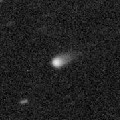
|
Now it is 13.3 mag (Sept. 5, Alan Hale). It is expected to brighten up to 7 mag in 2017 summer. In the Northern Hemisphere, it becomes low temporarily in summer, but it keeps observable in good condition until the highlight while the comet will be brightening. In the Southern Hemisphere, it is not observable until early 2017.
Date(TT) R.A. (2000) Decl. Delta r Elong. m1 Best Time(A, h)
Sept.17 10 46.44 49 25.1 4.233 3.645 48 13.4 4:32 (228,-30)
Sept.24 11 0.60 48 53.8 4.120 3.578 51 13.3 4:22 (229,-30)
|

|
Now it is 13.5 mag (Aug. 30, Jakub Cerny). It is observable in excellent condition in the Southern Hemisphere.
Date(TT) R.A. (2000) Decl. Delta r Elong. m1 Best Time(A, h)
Sept.17 19 14.77 -25 15.6 5.445 5.903 112 13.5 19:28 (180, 80)
Sept.24 19 15.19 -25 6.6 5.549 5.902 105 13.5 19:22 (154, 79)
|

|
It keeps unobservable for a long time. It will appear in the morning sky in December, when the comet will be fainter than 15 mag.
Date(TT) R.A. (2000) Decl. Delta r Elong. m1 Best Time(A, h)
Sept.17 11 4.90 -0 33.0 2.427 1.443 8 13.5 4:32 (277, -9)
Sept.24 11 27.36 -2 38.0 2.447 1.467 9 13.6 4:22 (280, -9)
|
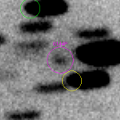
|
It became so bright as 8 mag in 2009. It was expected to brighten up to 11-12 mag from summer to autumn. But actually, it is 13.9 mag (Sept. 2, Kunihiro Shima), fainter than originally expected by 3 mag. It keeps locating low for a while. Juan Jose Gonzalez reported it so bright as 9.2 mag on Sept. 9.
Date(TT) R.A. (2000) Decl. Delta r Elong. m1 Best Time(A, h)
Sept.17 9 19.81 13 23.5 2.128 1.444 36 13.9 4:32 (251, 4)
Sept.24 9 41.07 11 28.2 2.119 1.457 37 13.8 4:22 (253, 4)
|
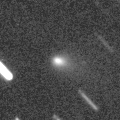
|
Now it is bright as 13.9 mag (Sept. 1, Sandor Szabo). It had been lost for a long time over 200 years since its discovery in 1783. In the Northern Hemisphere, it is observable in excellent condition from summer to winter. In the Southern Hemisphere, it keeps observable in good condition until November.
Date(TT) R.A. (2000) Decl. Delta r Elong. m1 Best Time(A, h)
Sept.17 5 17.74 11 41.0 1.388 1.780 94 14.0 4:32 (200, 41)
Sept.24 5 24.07 14 29.5 1.315 1.785 99 13.9 4:22 (196, 39)
|
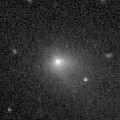
|
Now it is 13.0 mag (Sept. 1, Seiichi Yoshida). Distant object, but it keeps observable at 13-14 mag for a long time from 2015 to 2016.
Date(TT) R.A. (2000) Decl. Delta r Elong. m1 Best Time(A, h)
Sept.17 0 47.74 -1 13.9 3.983 4.952 162 13.9 1:04 (180, 56)
Sept.24 0 45.76 -1 50.2 3.971 4.961 169 13.9 0:35 (180, 57)
|

|
Now it is 13.7 mag (Aug. 27, Sandor Szabo). It will be fading gradually after this. In the Northern Hemisphere, it keeps observable until early November. It becomes observable in the evening sky from July to September also in the Southern Hemisphere.
Date(TT) R.A. (2000) Decl. Delta r Elong. m1 Best Time(A, h)
Sept.17 15 30.85 19 1.4 3.717 3.314 59 14.1 19:16 (128, 16)
Sept.24 15 35.99 16 41.1 3.831 3.356 54 14.3 19:22 (121, 13)
|
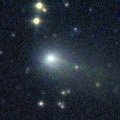
|
It brightened up to 12.5 mag in summer (Aug. 3, Marco Goiato). Now it is fading. It has already faded down to 14.0 mag (Sept. 1, Seiichi Yoshida). It keeps observable in good condition for a while.
Date(TT) R.A. (2000) Decl. Delta r Elong. m1 Best Time(A, h)
Sept.17 20 51.75 -17 2.7 1.859 2.677 136 14.4 21:05 (180, 72)
Sept.24 20 53.21 -17 16.4 1.947 2.701 129 14.6 20:39 (180, 72)
|
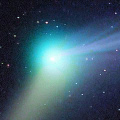
|
It brightened up to 6 mag from autumn to winter. Now it is fading. It has already faded down to 13.9 mag (Aug. 31, Jakub Cerny). It is observable in good condition in the Northern Hemisphere. It is not observable after this in the Southern Hemisphere.
Date(TT) R.A. (2000) Decl. Delta r Elong. m1 Best Time(A, h)
Sept.17 6 0.17 52 59.6 4.296 4.326 85 14.5 4:32 (195, -1)
Sept.24 5 55.74 53 46.0 4.256 4.400 91 14.6 4:22 (192, -1)
|
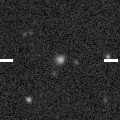
|
Now it is 16.4 mag (Aug. 12, Thomas Lehmann). It will be unobservable temporarily from summer to autumn. Then it will appear in the morning sky at 13 mag in December. It is expected to brighten up to 7 mag in 2017 spring. But it locates somewhat low at the high light.
Date(TT) R.A. (2000) Decl. Delta r Elong. m1 Best Time(A, h)
Sept.17 12 18.91 -5 52.3 4.413 3.440 12 15.1 19:16 ( 79, -5)
Sept.24 12 27.03 -6 39.2 4.353 3.363 8 15.0 19:22 ( 74,-10)
|
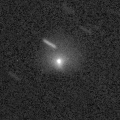
|
It has brightened in outburst up to 14 mag twice, in 2006 January and 2011 May. Third outburst occured on Aug. 28, and now it is bright as 14.8 mag (Aug. 30, Juan Jose Gonzalez). It is observable in good condition in autumn.
Date(TT) R.A. (2000) Decl. Delta r Elong. m1 Best Time(A, h)
Sept.17 1 22.89 6 29.3 5.396 6.306 152 15.1 1:39 (180, 48)
Sept.24 1 20.75 6 12.8 5.366 6.319 160 15.2 1:09 (180, 49)
|

|
In the Northern Hemisphere, it will be observable at 15 mag in good condition from September to October. In the Southern Hemisphere, it is not observable until November.
Date(TT) R.A. (2000) Decl. Delta r Elong. m1 Best Time(A, h)
Sept.17 11 5.67 53 32.6 0.441 0.810 51 15.8 4:32 (225,-34)
Sept.24 11 31.60 68 30.7 0.409 0.939 69 15.3 4:22 (207,-37)
|
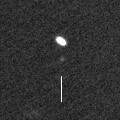
|
It is appearing in the morning sky in the Northern Hemisphere. It is expected to brighten up to 14 mag from winter to spring in 2017, and it will be observable in excellent condition in the Northern Hemisphere. In the Southern Hemisphere, it keeps extremely low until autumn, and it will be low also around the higlight.
Date(TT) R.A. (2000) Decl. Delta r Elong. m1 Best Time(A, h)
Sept.17 8 49.84 27 43.6 3.066 2.503 47 15.6 4:32 (235, 0)
Sept.24 9 4.41 27 24.2 2.990 2.490 51 15.5 4:22 (235, 1)
|
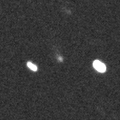
|
No observations have been reported since June. It will be unobservable after this in the Northern Hemisphere. It will be low from autumn to winter also in the Southern Hemisphere.
Date(TT) R.A. (2000) Decl. Delta r Elong. m1 Best Time(A, h)
Sept.17 12 41.84 -57 15.0 2.836 2.505 60 15.7 19:16 ( 37, 26)
Sept.24 13 10.53 -56 27.9 2.929 2.536 57 15.9 19:22 ( 37, 26)
|

|
Appearing in the morning sky in the Northern Hemisphere. It keeps unobservable until October in the Southern Hemisphere.
Date(TT) R.A. (2000) Decl. Delta r Elong. m1 Best Time(A, h)
Sept.17 9 46.34 11 10.1 2.927 2.109 29 15.8 4:32 (257, 0)
Sept.24 10 0.87 10 7.6 2.906 2.128 32 16.0 4:22 (257, 1)
|

|
It has been lost since its discovery in 1978. In 2016, it is expected to return in excellent condition from autumn to winter.
Date(TT) R.A. (2000) Decl. Delta r Elong. m1 Best Time(A, h)
Sept.17 19 38.90 -32 4.8 0.681 1.443 116 16.1 19:53 (180, 87)
Sept.24 19 47.87 -31 29.0 0.685 1.408 111 15.9 19:34 (180, 86)
|
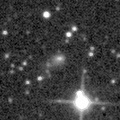
|
Now it is 16.2 mag (Aug. 31, Sandor Szabo). It will be observable at 13 mag for a long time from 2017 to 2018. In 2016, it keeps observable at 16 mag in good condition until autumn.
Date(TT) R.A. (2000) Decl. Delta r Elong. m1 Best Time(A, h)
Sept.17 18 38.72 -9 15.2 5.440 5.783 105 16.1 19:16 (166, 64)
Sept.24 18 35.87 -9 8.5 5.519 5.741 97 16.1 19:22 (148, 61)
|
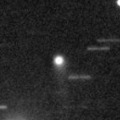
|
Now it is 15.3 mag (Sept. 1, Sandor Szabo). It will brighten up to 14 mag from summer to winter in 2017. Then it will be observable in excellent condition in the Northern Hemisphere. In the Southern Hemisphere, it is hardly observable around the highlight.
Date(TT) R.A. (2000) Decl. Delta r Elong. m1 Best Time(A, h)
Sept.17 23 44.27 -17 31.0 3.672 4.649 164 16.2 0:01 (180, 72)
Sept.24 23 36.60 -17 13.0 3.645 4.605 161 16.1 23:21 (180, 72)
|

|
It brightened up to 13.0 mag in spring (May 6, Marco Goiato). It is already unobservable in the Northern Hemisphere. In the Southern Hemisphere, it keeps observable in good condition until autumn. But it will be fading slowly after this.
Date(TT) R.A. (2000) Decl. Delta r Elong. m1 Best Time(A, h)
Sept.17 14 38.67 -33 11.7 2.914 2.482 55 16.2 19:16 ( 72, 37)
Sept.24 14 52.51 -34 12.0 2.990 2.497 51 16.3 19:22 ( 69, 33)
|
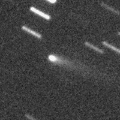
|
Now it is 15.0 mag (Sept. 1, Sandor Szabo). It will be observable at 15-16 mag in good condition from autumn to winter. It locates somewhat low in the Southern Hemisphere.
Date(TT) R.A. (2000) Decl. Delta r Elong. m1 Best Time(A, h)
Sept.17 4 31.70 30 39.6 2.126 2.552 103 16.2 4:32 (184, 24)
Sept.24 4 37.14 31 20.0 2.057 2.562 108 16.2 4:22 (181, 24)
|
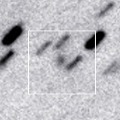
|
Now it is 16.5 mag (Apr. 5, Yasukazu Ikari). It keeps 16-17 mag for a long time from 2016 to 2019. It keeps locating near by the equator.
Date(TT) R.A. (2000) Decl. Delta r Elong. m1 Best Time(A, h)
Sept.17 9 3.33 3 9.9 10.524 9.762 38 16.4 4:32 (257, 13)
Sept.24 9 6.29 2 58.3 10.443 9.755 44 16.4 4:22 (255, 16)
|
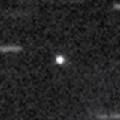
|
Now it is 16.5 mag (Aug. 25, Alexander Baransky). It will brighten up to 15 mag in winter. But it will be getting lower gradually after autumn.
Date(TT) R.A. (2000) Decl. Delta r Elong. m1 Best Time(A, h)
Sept.17 22 9.96 -10 59.4 1.391 2.346 156 16.7 22:22 (180, 66)
Sept.24 22 3.96 -10 45.5 1.390 2.304 148 16.5 21:49 (180, 66)
|
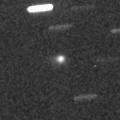
|
Now it is 16.3 mag (Aug. 31, Kunihiro Shima). It will brighten up to 13 mag and will be observable in good condition in 2017 summer. In 2016, it keeps observable until winter when it will brighten up to 15.5 mag. It locates somewhat low in the Southern Hemisphere.
Date(TT) R.A. (2000) Decl. Delta r Elong. m1 Best Time(A, h)
Sept.17 3 14.44 31 37.0 3.802 4.375 118 16.8 3:31 (180, 23)
Sept.24 3 5.27 31 38.9 3.645 4.325 127 16.7 2:54 (180, 23)
|
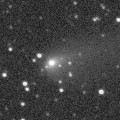
|
It was observed at 13 mag for a long time from winter to early summer. Now it is fading. It has already faded down to 16.8 mag (Aug. 16, CAO, San Pedro de Atacama). It is observable in excellent condition in the Southern Hemisphere. But it locates somewhat low in the Northern Hemisphere.
Date(TT) R.A. (2000) Decl. Delta r Elong. m1 Best Time(A, h)
Sept.17 16 27.55 -25 2.7 2.832 2.747 74 16.7 19:16 ( 96, 55)
Sept.24 16 37.76 -25 19.7 2.943 2.772 70 16.9 19:22 ( 92, 51)
|

|
Now it is 15.7 mag (Aug. 25, Alexander Baransky). It keeps 16.5 mag from 2016 to 2017. It is observable in good condition in the Northern Hemisphere. In the Southern Hemisphere, it locates low in 2016, and it is not observable in 2017.
Date(TT) R.A. (2000) Decl. Delta r Elong. m1 Best Time(A, h)
Sept.17 16 35.41 33 39.5 6.447 6.272 75 16.8 19:16 (149, 13)
Sept.24 16 37.80 33 22.2 6.498 6.267 72 16.8 19:22 (143, 10)
|
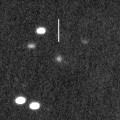
|
Now it is 18.5 mag (Aug. 11, CAO, San Pedro de Atacama). It will be observable at 16 mag in good condition from autumn to winter. It locates low in the Southern Hemisphere.
Date(TT) R.A. (2000) Decl. Delta r Elong. m1 Best Time(A, h)
Sept.17 7 3.59 24 6.5 4.130 3.899 69 16.9 4:32 (220, 19)
Sept.24 7 9.54 24 5.3 4.022 3.891 75 16.8 4:22 (218, 20)
|
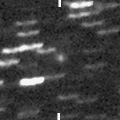
|
Now it is 16.6 mag (Aug. 4, A. Diepvens). It keeps 16-17 mag and keeps observable in good condition until autumn.
Date(TT) R.A. (2000) Decl. Delta r Elong. m1 Best Time(A, h)
Sept.17 17 52.25 -12 11.6 2.307 2.575 93 16.8 19:16 (141, 62)
Sept.24 17 59.14 -12 25.1 2.377 2.558 88 16.9 19:22 (130, 59)
|
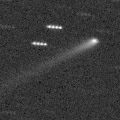
|
It brightened up to 15 mag from late 2014 to early 2016. Now it is fading slowly. Now it is 16.1 mag (Aug. 16, D. Buczynski). In the Northern Hemisphere, it will be observable at 16-17 mag in autumn in good condition. It locates extremely low in the Southern Hemisphere.
Date(TT) R.A. (2000) Decl. Delta r Elong. m1 Best Time(A, h)
Sept.17 22 21.10 43 35.2 4.496 5.210 130 17.0 22:33 (180, 11)
Sept.24 22 9.83 42 53.3 4.536 5.243 130 17.1 21:54 (180, 12)
|
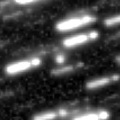
|
Now it is 16.9 mag (July 30, Yasukazu Ikari). It will brighten up to 16 mag and will be observable in good condition in 2017. In 2016, it is observable in excellent condition in the Southern Hemisphere, but it keeps low in the Northern Hemisphere.
Date(TT) R.A. (2000) Decl. Delta r Elong. m1 Best Time(A, h)
Sept.17 18 41.81 -36 6.8 2.788 3.184 103 17.1 19:16 ( 74, 86)
Sept.24 18 45.82 -35 27.6 2.864 3.167 98 17.1 19:22 ( 84, 80)
|
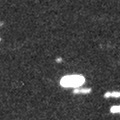
|
Now it is 17.5 mag (Aug. 4, Toshiyuki Takahashi). It will brighten up to 15 mag and will be observable in good condition from autum to winter in 2017. In the Northern Hemisphere, it keeps observable in good condition for a long time while the comet will be brightening. It is not observable until 2017 summer in the Southern Hemisphere.
Date(TT) R.A. (2000) Decl. Delta r Elong. m1 Best Time(A, h)
Sept.17 5 9.38 58 15.9 5.525 5.649 91 17.2 4:32 (187, -4)
Sept.24 5 3.51 58 43.3 5.382 5.614 98 17.1 4:22 (184, -4)
|
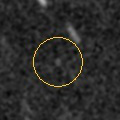
|
First return of a new periodic comet discovered in 2007. Now it is 19.4 mag (Sept. 1, K. Sarneczky, P. Szekely). It was expected to brighten up to 16.5 mag and will be observable in good condition from autumn to winter. But actually, it is fainter than predicted by 1.5 mag.
Date(TT) R.A. (2000) Decl. Delta r Elong. m1 Best Time(A, h)
Sept.17 3 39.39 -10 47.4 1.875 2.530 119 17.4 3:55 (180, 66)
Sept.24 3 41.86 -11 26.4 1.794 2.505 124 17.3 3:30 (180, 66)
|
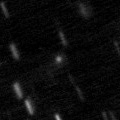
|
Now it is 18.0 mag (July 24, CAO, San Pedro de Atacama). It keeps 17 mag for a long time in 2016, and it will be observable in excellent condition in the Southern Hemisphere. It is hardly observable in the Northern Hemisphere.
Date(TT) R.A. (2000) Decl. Delta r Elong. m1 Best Time(A, h)
Sept.17 2 7.93 -51 28.9 2.959 3.592 121 17.4 2:24 ( 0, 74)
Sept.24 1 46.43 -52 2.1 2.966 3.615 123 17.4 1:36 ( 0, 73)
|
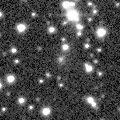
|
It will pass the perihelion in 2019. However, it has not been brightening since the discovery in 2010. Now it is 18.1 mag (Aug. 10, D. Buczynski). It keeps observable in excellent condition in the Northern Hemisphere. It is not observable in the Southern Hemisphere.
Date(TT) R.A. (2000) Decl. Delta r Elong. m1 Best Time(A, h)
Sept.17 4 44.01 57 11.8 9.775 9.922 95 17.4 4:32 (184, -2)
Sept.24 4 43.99 57 48.2 9.662 9.901 100 17.4 4:22 (181, -3)
|
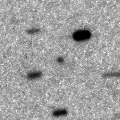
|
Now it is 17.9 mag (Aug. 25, Alexander Baransky). It will be observable at 17.5 mag in good condition in autumn.
Date(TT) R.A. (2000) Decl. Delta r Elong. m1 Best Time(A, h)
Sept.17 23 1.49 3 41.1 1.554 2.547 168 17.5 23:14 (180, 51)
Sept.24 22 57.60 3 12.2 1.545 2.522 163 17.5 22:42 (180, 52)
|
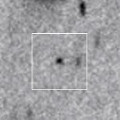
|
Now it is 19.3 mag (Aug. 31, Kunihiro Shima). It will pass the perihelion on Mar. 10, 2017. In the Northern Hemisphere, it keeps observable in the evening sky until late February while the comet will be brightening up to 8.5 mag. In the Southern Hemisphere, it will appear in the morning sky in late March at 8 mag, then it keeps observable while the comet will be fading.
Date(TT) R.A. (2000) Decl. Delta r Elong. m1 Best Time(A, h)
Sept.17 0 42.92 15 56.2 1.588 2.539 155 17.8 1:00 (180, 39)
Sept.24 0 31.89 15 25.8 1.501 2.479 163 17.6 0:21 (180, 39)
|

|
It brightened up to 13-14 mag from 2014 to 2015. Now it is fading. It has already faded down to 17.0 mag (Aug. 12, iTelescope Observatory, Siding Spring). It will be fainter than 18 mag in October.
Date(TT) R.A. (2000) Decl. Delta r Elong. m1 Best Time(A, h)
Sept.17 23 8.35 -6 12.9 4.783 5.779 171 17.6 23:21 (180, 61)
Sept.24 23 5.83 -6 36.6 4.854 5.824 163 17.6 22:51 (180, 62)
|
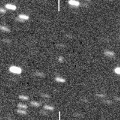
|
First return of a new periodic comet discovered in 2008. Now it is 18.8 mag (Aug. 1, M. Jaeger, E. Prosperi, S. Prosperi, W. Vollmann). It keeps observable at 17.5 mag until autumn.
Date(TT) R.A. (2000) Decl. Delta r Elong. m1 Best Time(A, h)
Sept.17 20 3.66 -19 20.7 2.395 3.080 124 17.7 20:17 (180, 74)
Sept.24 20 4.86 -19 15.5 2.474 3.077 118 17.7 19:51 (180, 74)
|
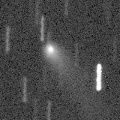
|
It was observed at 14-15 mag from 2014 to 2015. Now it is fading. It has already faded down to 17.3 mag (Aug. 10, D. Buczynski). In the Northern Hemisphere, it keeps observable in excellent condition until winter when the comet will be fainter than 18 mag. It is not observable in the Southern Hemisphere.
Date(TT) R.A. (2000) Decl. Delta r Elong. m1 Best Time(A, h)
Sept.17 4 56.19 78 15.0 5.944 6.027 89 17.7 4:32 (182,-23)
Sept.24 4 58.60 79 26.9 5.926 6.069 93 17.7 4:22 (181,-25)
|
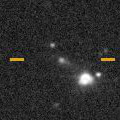
|
It is 16.8 mag now (Aug. 31, Kunihiro Shima). It was expected to brighten up to 16 mag and observable in good condition in autumn. But actually, it is fainter than originally predicted.
Date(TT) R.A. (2000) Decl. Delta r Elong. m1 Best Time(A, h)
Sept.17 22 48.79 -11 59.4 1.788 2.769 164 17.7 23:01 (180, 67)
Sept.24 22 43.96 -11 54.4 1.802 2.752 156 17.7 22:29 (180, 67)
|
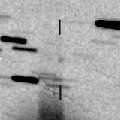
|
First return of a new periodic comet discovered in 2005. Now it is 18.9 mag (Aug. 28, K. Sarneczky, P. Szekely). In the Northern Hemisphere, it will be observable at 17 mag in excellent condition in winter. It locates somewhat low in the Southern Hemisphere.
Date(TT) R.A. (2000) Decl. Delta r Elong. m1 Best Time(A, h)
Sept.17 3 55.79 23 46.7 2.296 2.837 112 17.8 4:12 (180, 31)
Sept.24 3 58.86 23 57.6 2.212 2.832 118 17.7 3:47 (180, 31)
|
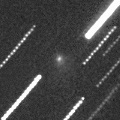
|
Now it is 17.9 mag (Aug. 8, J. Gonzalez). It keeps 17-18 mag until autumn. It keeps observable in excellent condition in the Northern Hemisphere. It will be getting lower gradually in the Southern Hemisphere.
Date(TT) R.A. (2000) Decl. Delta r Elong. m1 Best Time(A, h)
Sept.17 19 3.51 37 3.9 1.940 2.409 105 17.8 19:16 (180, 18)
Sept.24 18 52.19 36 28.2 2.052 2.434 99 17.9 19:22 (171, 18)
|
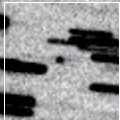
|
Now it is 17.6 mag (Aug. 6, iTelescope SRO Observatory, Auberry). In the Northern Hemisphere, it will be observable at 17 mag in excellent condition in winter. It locates low in the Southern Hemisphere.
Date(TT) R.A. (2000) Decl. Delta r Elong. m1 Best Time(A, h)
Sept.17 6 38.73 31 22.7 3.495 3.397 76 17.8 4:32 (211, 16)
Sept.24 6 46.63 31 32.0 3.398 3.393 81 17.8 4:22 (209, 17)
|
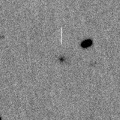
|
First return of a new periodic comet which brightened up to 16.5 mag in 2008. The condition of this apparition is very good. It was expected to brighten up to 15.5 mag in autumn and will be observable in good condition. But actually, it is 17.4 mag (Aug. 31, Kunihiro Shima), fainter than originally expected by 2-3 mag.
Date(TT) R.A. (2000) Decl. Delta r Elong. m1 Best Time(A, h)
Sept.17 23 58.27 -14 4.1 1.360 2.351 167 17.9 0:15 (180, 69)
Sept.24 23 49.91 -13 10.1 1.356 2.341 165 17.9 23:34 (180, 68)
|
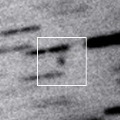
|
Now it is 17.4 mag (July 2, G. Gunn, G. W. Christie). It keeps observable at 17.5 mag in good condition from spring to autumn in the Southern Hemisphere. It is not observable in the Northern Hemisphere.
Date(TT) R.A. (2000) Decl. Delta r Elong. m1 Best Time(A, h)
Sept.17 17 52.29 -56 27.2 4.800 4.967 93 17.9 19:16 ( 24, 66)
Sept.24 17 58.57 -55 37.4 4.886 4.968 88 17.9 19:22 ( 31, 64)
|
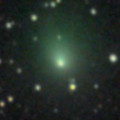
|
It brightened up to 10 mag in 2015 autumn. Now it is fading. It has already faded down to 17.8 mag (Aug. 26, Alexander Baransky). It will be fainter than 18 mag soon.
Date(TT) R.A. (2000) Decl. Delta r Elong. m1 Best Time(A, h)
Sept.17 3 39.99 13 36.7 2.567 3.169 118 17.9 3:56 (180, 41)
Sept.24 3 38.44 13 21.4 2.520 3.207 125 17.9 3:27 (180, 42)
|
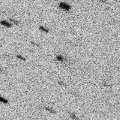
|
Now it is 17.0 mag (Aug. 31, Kunihiro Shima). It is observable at 18 mag in excellent condition in autumn.
Date(TT) R.A. (2000) Decl. Delta r Elong. m1 Best Time(A, h)
Sept.17 1 38.50 8 33.8 1.730 2.639 148 17.9 1:55 (180, 46)
Sept.24 1 35.13 8 24.2 1.705 2.653 156 17.9 1:24 (180, 47)
|
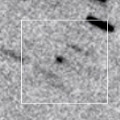
|
Now it is 18.6 mag (Aug. 31, Kunihiro Shima). It is observable at 18 mag in excellent condition in autumn.
Date(TT) R.A. (2000) Decl. Delta r Elong. m1 Best Time(A, h)
Sept.17 1 9.23 3 50.1 1.641 2.594 156 17.9 1:26 (180, 51)
Sept.24 1 5.17 3 35.6 1.623 2.604 164 17.9 0:54 (180, 51)
|
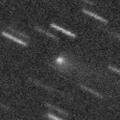
|
It became brighter than expected, brightened up to 15.1 mag from June to July (June 14, Hidetaka Sato). Now it is fading rapidly. It has already faded down to 18.9 mag (Sept. 1, Kunihiro Shima). In the Northern Hemisphere, it is observable in excellent condition. It locates low in the Southern Hemisphere.
Date(TT) R.A. (2000) Decl. Delta r Elong. m1 Best Time(A, h)
Sept.17 6 33.06 26 56.7 1.598 1.685 76 18.0 4:32 (212, 20)
Sept.24 6 46.77 28 26.1 1.572 1.726 80 18.3 4:22 (211, 19)
|
|
![]()
 315P/2013 V6 ( LONEOS )
315P/2013 V6 ( LONEOS ) C/2015 T4 ( PanSTARRS )
C/2015 T4 ( PanSTARRS ) 118P/Shoemaker-Levy 4
118P/Shoemaker-Levy 4 D/1978 R1 ( Haneda-Campos )
D/1978 R1 ( Haneda-Campos ) C/2015 O1 ( PanSTARRS )
C/2015 O1 ( PanSTARRS ) C/2016 N4 ( MASTER )
C/2016 N4 ( MASTER ) 77P/Longmore
77P/Longmore 56P/Slaughter-Burnham
56P/Slaughter-Burnham C/2014 B1 ( Schwartz )
C/2014 B1 ( Schwartz ) 93P/Lovas 1
93P/Lovas 1 C/2015 VL62 ( Lemmon-Yeung-PanSTARRS )
C/2015 VL62 ( Lemmon-Yeung-PanSTARRS ) 116P/Wild 4
116P/Wild 4 C/2014 OE4 ( PanSTARRS )
C/2014 OE4 ( PanSTARRS ) 74P/Smirnova-Chernykh
74P/Smirnova-Chernykh 219P/LINEAR
219P/LINEAR C/2014 A4 ( SONEAR )
C/2014 A4 ( SONEAR ) 47P/Ashbrook-Jackson
47P/Ashbrook-Jackson C/2015 V1 ( PanSTARRS )
C/2015 V1 ( PanSTARRS ) P/2016 R1 ( Catalina )
P/2016 R1 ( Catalina ) C/2015 B2 ( PanSTARRS )
C/2015 B2 ( PanSTARRS ) C/2010 U3 ( Boattini )
C/2010 U3 ( Boattini ) 343P/2016 P3 ( NEAT-LONEOS )
343P/2016 P3 ( NEAT-LONEOS ) 2P/Encke
2P/Encke C/2012 F3 ( PanSTARRS )
C/2012 F3 ( PanSTARRS ) 340P/2016 N2 ( Boattini )
340P/2016 N2 ( Boattini ) C/2014 N3 ( NEOWISE )
C/2014 N3 ( NEOWISE ) 188P/LINEAR-Mueller
188P/LINEAR-Mueller P/2016 Q1 ( Read )
P/2016 Q1 ( Read ) C/2016 K1 ( LINEAR )
C/2016 K1 ( LINEAR ) P/2015 TP200 ( LINEAR )
P/2015 TP200 ( LINEAR ) 338P/2016 N1 ( McNaught )
338P/2016 N1 ( McNaught ) C/2015 H2 ( PanSTARRS )
C/2015 H2 ( PanSTARRS ) 22P/Kopff
22P/Kopff 341P/2016 N3 ( Gibbs )
341P/2016 N3 ( Gibbs ) 208P/McMillan
208P/McMillan 146P/Shoemaker-LINEAR
146P/Shoemaker-LINEAR![]()





















































